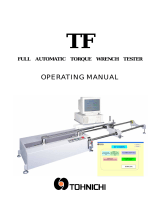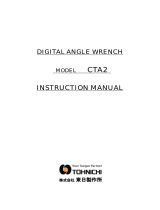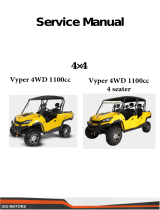Page is loading ...

OPERATING INSTRUCTION
To use this product properly and safely, please read this manual carefully before use. If you have
any question about the product and its operations, please contact your nearest distributor or
TOHNICHI MFG. CO., LTD.
BOLT TENSION METER
MODEL B-BTM
B-BTM B-BTM Model

1
■BOLT TENSION METER MODEL B-BTM
Before using this product, please read this operating instruction carefully to use it properly. If you
have any question, please contact your nearest distributor or TOHNICHI MFG. CO., LTD. This
operating instruction should be stored in a safe place.
Safety Precautions
Safety Symbol
This symbol is used for drawing attention to "safety precautions". If you see this
symbol in this operating instruction, attention should be paid to safety. Take
preventative actions according to the description and conduct "safe operations
and proper control".
Signal Words
The signal words are the headers which indicate the level of hazard that should be known for
human safety and in handling devices. The signal words for safety are "Danger", "Warning" and
"Caution" depending on the level of hazard to human. The signal words are used with the safety
symbol to indicate the following situations.
" Danger": Indicates an imminently hazardous situation which, if not avoided, will
result in death or serious injury.
" Warning": Indicates a potentially hazardous situation which, if not avoided, could
result in death or serious injury.
" Caution": Indicates a potentially hazardous situation which, if not avoided, may
result in minor or moderate injury.

2
■BOLT TENSION METER MODEL B-BTM
• Before use, fix this meter with bolts to a stable object such as workbench and steel frame that
has a sufficient strength. If its fixing state is not proper, the meter may fall down or drop off,
resulting in an accident.
• Do not remodel the meter. Remodeling may cause an accuracy error or damage to the meter.
Warning
• This meter is a precision measuring instrument. Do not give a strong impact to the meter by
dropping or throwing it.
It may cause an accuracy error or a failure. Take due care when carrying the meter.
• Do not expose the meter to rain. Do not use it in a hot and humid place. Rust may cause a
malfunction.
• Do not use in a dusty place. Use in a dusty place may cause an accuracy error or a failure.
• Before starting the operation, warm up the meter till oil operates smoothly. Particularly in
winter, oil viscosity is increased, and indicated values may become lower.
• When using the meter in summer, do not expose it to direct sunlight for a long time.
• After completion of measurement, loosen the bolt immediately. Leaving it under loaded
conditions may cause leakage of oil.
• Bring the head plate into contact with the piston properly. Incomplete fitting may damage the
meter.
Precautions for use

■BOLT TENSION METER MODEL B-BTM
3
1. Outline ........................................................................... 4
2. Components (Each Part Name).................................... 4
3. Major Specifications ..................................................... 5
4. How to Use.................................................................... 6
4-1. Standard bolt test ................................................... 6
4-2. Power wrench capacity measurement..................... 6
5. Excerpts from JIS B 1986 ............................................. 7
5-1. Torque coefficient values of sets.............................. 7
5-2. Measurement of torque coefficient values of sets .... 8
5-3. Inspection of torque coefficient values of sets.......... 9
6. Appendix (Dimensional Drawing/Specifications) ........ 10
Contents

4
■BOLT TENSION METER MODEL B-BTM
The bolt tension meter is an instrument for measuring the bolt axial tension generated when the
bolt and nut are tightened in combination.
Combined use of a bolt tension meter and a torque wrench permits a simplified determination
of the torque coefficient of a tightening device.
It is possible to measure the tightening capacity of power wrench.
1
Outline
This bolt tension meter is made up with the following parts:
2
Components (Each Part Name)
(1): Cylinder
(2): Piston
(3): Piston pin
(4): Flange
(5): O-ring
(6): O-ring
(7): O-ring
(8): C-type snap ring
(9): Bolt
(10): Bolt
(11): Axial tension gauge
(12): Nut plate
(13): Head plate
Accessories
· Case
· Spanner
For mounting a nut plate)
· Bolt
For mounting a nut plate)
· Calibration certificate
· Operating Instruction
(11)
(4)
(1)
(6)
(12)
(9)
(10)
(5)
(7)
(2)
(13)
(3)
(8)

There are 4 models for B-BTM. Each specification is as shown in Table 1.
Table 1 Major Specifications of B-BTM
3
Specifications
5
■BOLT TENSION METER MODEL B-BTM
Axial tension measurement range (kN) Measurable bolt size
Model
Min. to Max. 1 graduation Bolt size (minimum length: mm)
B-BTM13K 1.2 to 13 0.2 M5(20), M6(21), M7(21.5), M8(22.5)
B-BTM40K 4 to 40 0.5 M10(29), M12(31), M14(32)
B-BTM130K 12 to 130 2 M16(41), M18(43), M20(44), M24(47)
B-BTM400K 40 to 400 5 M27(72), M30(74), M36(79), M42(84)

6
■BOLT TENSION METER MODEL B-BTM
Bolt test and power wrench capacity measurement with the bolt tension meter shall be carried
out according to the following procedures:
4-1. Standard bolt test (measurement of torque coefficient)
(1) Preparation
a) Fix the bolt tension meter to a workbench or steel frame.
b) Attach the nut plate and head plate that fit the bolt size to the meter.
(2) Bolt test
a) Insert the bolt to be tested from the head plate side and tighten the nut from the nut plate
side. (Refer to the dimensional drawing on the back cover.)
b) Gradually apply force to the torque wrench to tighten the nut, and read the axial tension at
the time when the testing torque is reached.
c) The torque coefficient is determined by the following expression:
K=T/(d·N) In this expression: K: Torque coefficient
T: Torque (N·m){kgf·cm}
d: Nominal diameter of bolt (cm)
N: Axial tension of bolt (N){kgf}
Note) 1. It is not desirable to test the same bolt repeatedly.
2. For a bolt test, refer to JIS B 1186.
4-2. Power wrench capacity measurement
(1) Insert the bolt from the head plate side, and tighten the nut lightly from the nut plate side.
(2) Tighten the nut with the power wrench for a predetermined time.
Note) 1. The tightening torque of power wrench (particularly impact wrench) varies depending
on the tightening conditions. Therefore, the value measured with this meter itself cannot
be regarded as a work tightening value.
4
How to use

The excerpts from "Sets of high strength hexagon bolt, hexagon nut and washer for friction grip
joints (JIS B 1186-1995)" are referred.
5-1. Torque coefficient values of sets
Torque coefficient values of sets measured according to the procedure mentioned in 5.2 must
meet the specified values shown in Table 2. In this case, the torque coefficient value is
determined by the following expression:
K=T/(d·N)·1000 In this expression: K: Torque coefficient value
T: Torque (Nut tightening moment)(N·m){kgf·m}
d: Standard outside diameter of bolt thread (mm)
N: Bolt axial tension(1) (N){kgf}
Table 2 Torque coefficient values of the sets
5
Excerpts from JIS B 1986
7
■BOLT TENSION METER MODEL B-BTM
Category
Types of sets by torque coefficient values
AB
Average value of torque coefficient values of 1 production lot(1) 0.110 to 0.150 0.150 to 0.190
Standard deviation of torque coefficient values of 1 production lot(1) below 0.110 below 0.013
Note (1) "1 production lot" means that bolts, nuts and washers included in a set are produced in
the same lots, respectively.
Bolts, nuts and washers in the same lots refer to those that meet the following conditions:
(1) Bolts produced in the same lot refer to bolts in 1 production lot where the bolts have
the same (a) dissolution number of material (steel), (b) grade by mechanical property,
(c) nominal diameter of thread, (d) length "l", (e) machining process and (f) heat
treatment conditions. However, bolts that have somewhat difference in length "l"
may be regarded as in the same lot.
(2) Nuts produced in the same lot refer to nuts in 1 production lot where the nuts have the
same (a) dissolution number of material (steel), (b) grade by mechanical property, (c)
nominal diameter of thread, (d) machining process and (e) heat treatment conditions,
and additionally, (f) surface treatment conditions if surface treatment is applied.
(3) Washers produced in the same lot refer to washers in 1 production lot where the
washers have the same (a) dissolution number of material (steel), (b) grade by
mechanical property, (c) nominal diameter of washers, (d) machining process and (e)
heat treatment conditions.

Remark: If the torque coefficient values of sets cannot be measured because the length "l" is
short, take the actions according to the agreement made with the supplier.
5-2. Measurement of torque coefficient values of sets
Torque coefficient values of sets shall be measured as follows:
(1) Torque coefficient values of sets shall be measured under the operating conditions, and the
coefficient values of the same test sample shall not be measured repeatedly.
(2) Use a torque tester or a tension meter for measurement.
If a torque tester is used, read a torque and an axial tension respectively by one-half of the
scale interval from the torque-axial tension diagram recorded in the gauge connected to the
tester.
If an axial tension meter is used, set a test sample to the tension meter, apply torque to the
nut gradually so that no error is produced. Then, measure the torque with a torque meter
(refer to JIS B 4650) and the bolt axial tension with the tension meter, respectively, by one-
half of the scale interval of the tester.
At this time, the washer shall not turn.
If the jig that comes in contact with the bearing surface of bolt is as hard as or harder than
the washer, the washer may be omitted from the bearing surface of bolt.
(3) Measure the torque applied to the nut and the bolt axial tension produced by the torque at 3
points where the bolt axial tension values are within the range shown in Table 3. If a torque
tester is used for measurement, the measurement may be carried out at one point around
the middle of the value shown in Table 3.
Table 3 Axial tension for measurement of torque coefficient value Unit: kN{kgf}
8
■BOLT TENSION METER MODEL B-BTM
Axial tension of bolt
Nominal diameter of thread
M12 M16 M20 M22 M24 M27 M30
F8T
38 to 51 71 to 95 110 to 148 136 to 184 159 to 214 206 to 279 252 to 341
{3875 to 5201} {7240 to 9687}
{11217 to 15092} {13868 to 18763} {16214 to 21822} {21006 to 28450} {25697 to 34772}
F10T
54 to 72 99 to 134 155 to 209 191 to 259 223 to 301 290 to 392 354 to 479
{5506 to 7342}
{10095 to 13664} {15806 to 21312} {19417 to 26411} {22740 to 30694} {29572 to 39973} {36098 to 48845}
F11T
57 to 76 105 to 141 163 to 221 202 to 273 235 to 318 306 to 414 374 to 506
{5812 to 7750}
{10707 to 14378} {16621 to 22536} {20598 to 27838} {23963 to 32427} {31203 to 42216} {38138 to 57598}

(4) Substitute the torques and axial tensions measured according to the procedure specified in
(3) and the standard outside diameters of bolt thread into the expression indicated in 5. to
determine 3 calculated values. Then, round off the average value of the 3 calculated values
(or round off the calculated value in the case where only one point is measured using a
torque tester) to the third decimal place according to the procedure specified in JIS Z 8401
to determine the torque coefficient value of the test sample.
(5) The scale interval of torque-axial tension drawing determined by the torque tester shall be 10 N·m
{1 kgf·m} or less for torque, and 1% or less of the axial tension to be measured for axial tension.
(6) The scale interval of the tension meter shall be 1% or less of the axial tension to be
measured. Its error shall be 2 % or less of the indicated value within the axial tension range
to be measured.
5-3. Inspection of torque coefficient values of sets
Torque coefficient values of sets measured according to the procedure mentioned in 11.2 must
meet the specified values shown in Table 2. The quality assurance level of the inspection lot(10)
shall be as follows:
(1) The quality assurance level of the standard deviation of torque coefficient value of the
inspection lot(10) shall be a risk rate of 5% or less and a standard relative error of 8% or less.
Remark: For the application of 5.3(1), if the process is in a steady condition, the recent x-R
control chart or inspection data including data of the inspection lot may be used.
If necessary, under the agreement made with the supplier, the standard relative error that is a
little larger than the specified value may be determined to reduce a test sample.
(2) The quality assurance level of the average value of torque coefficient value of the inspection
lot(10) shall be larger than the value indicated in Table 9.
Note (10) "1 inspection lot" refers to 1 production lot specified in (3) of Note (1) in the section 5.
Table 4 Quality assurance level of average value of torque coefficient values
9
■BOLT TENSION METER MODEL B-BTM
Types of sets by torque Lower limit values Upper limit values
coefficient values m0”(α·
=
·0.05) m1”(α·
=
·0.10) m0’(α·
=
·0.05) m1’(α·
=
·0.10)
A 0.110 0.100 0.150 0.160
B 0.150 0.140 0.190 0.200
Remark: 1. The meanings of m0”, m1”, m0’ and m1’ shall be specified in JIS Z 9003.
2. For the standard deviation, the value determined by 5.3(1) shall be used.

10
6
Appendix (Dimensional Drawing/Specifications)
■BOLT TENSION METER MODEL B-BTM
■Model B-BTM
■Specifications Accuracy: ±3%
Model
Measuring range of
axial tension [kN] Measurable bolt [mm]
Min. to Max. 1
graduation
Bolt size (minimum length)
Optimum
under
head
length
[mm]
Measurable bolt [mm]
Total
ength
Total
thickness
Total
height Main body
Approx.
weight
[kg]
B-BTM13K
B-BTM14K
B-BTM140K
B-BTM400K
1.2 to 13
4 to 40
12 to 130
40 to 400
0.2
0.5
2
5
BEHbchdH
1H2
106 78 217 86 10 6 46 119 7.7
135 82 241
62
110 12 7 58 131 9.8
188 106 287 87 156 16 12 81 154 17.5
280 126 369 90 240 25 14 122 195 31.0
M5(20), M6(21)
M7(21.5), M8(22.5)
Standard
bolts
M10(29), M12(31)
M14(32)
M16(41), M18(43)
M20(44), M24(47)
M27(72), M30(74)
M36(79), M42(84)
Plate
c
Bolt tension
scale
4-φd hole
(for mounting)
Bolt to be measured
B
hH1H252
H
b
E

■ TOHNICHI MFG. CO., LTD.
TEL: +81-3-3762-2455 FAX: +81-3-3761-3852
2-12, Omori-kita, 2-Chome Ota-ku, Tokyo 143-0016, JAPAN
E-mail: [email protected]
Website: http://tohnichi.jp
■ N. V. TOHNICHI EUROPE S. A.
TEL: +32-16-606661 FAX: +32-16-606675
Industrieweg 27 Boortmeerbeek, B-3190 Belgium
E-mail: [email protected]
Website: http://www.tohnichi.be
■ TOHNICHI AMERICA CORP.
TEL: +1-847-272-8480 FAX: +1-847-272-8714
677 Academy Drive, Northbrook, Illinois 60062, U. S. A.
E-mail: [email protected]
Website: http://www.tohnichi.com
Designs and specifications are subject to change without notice.
/













